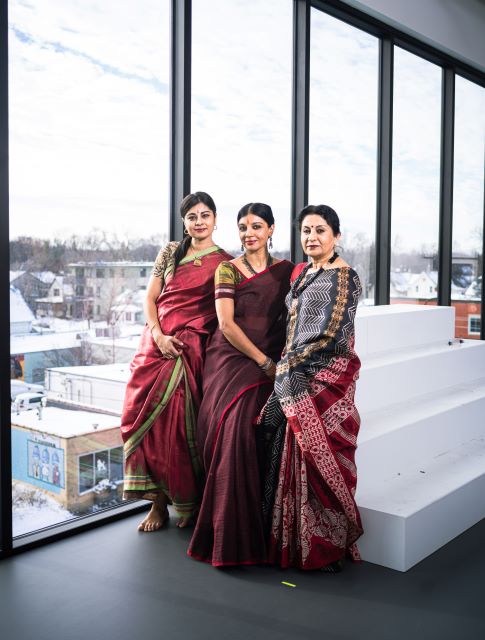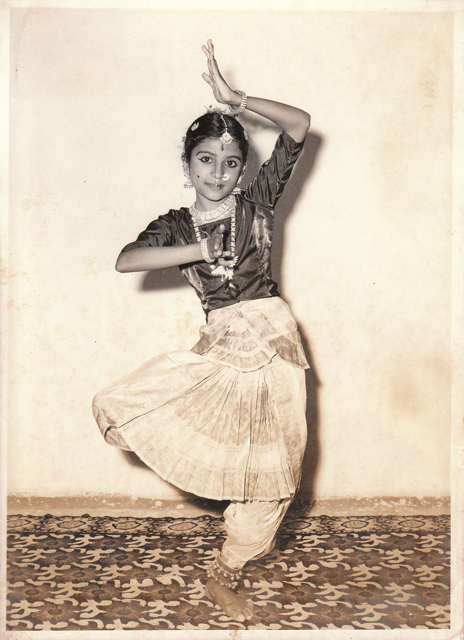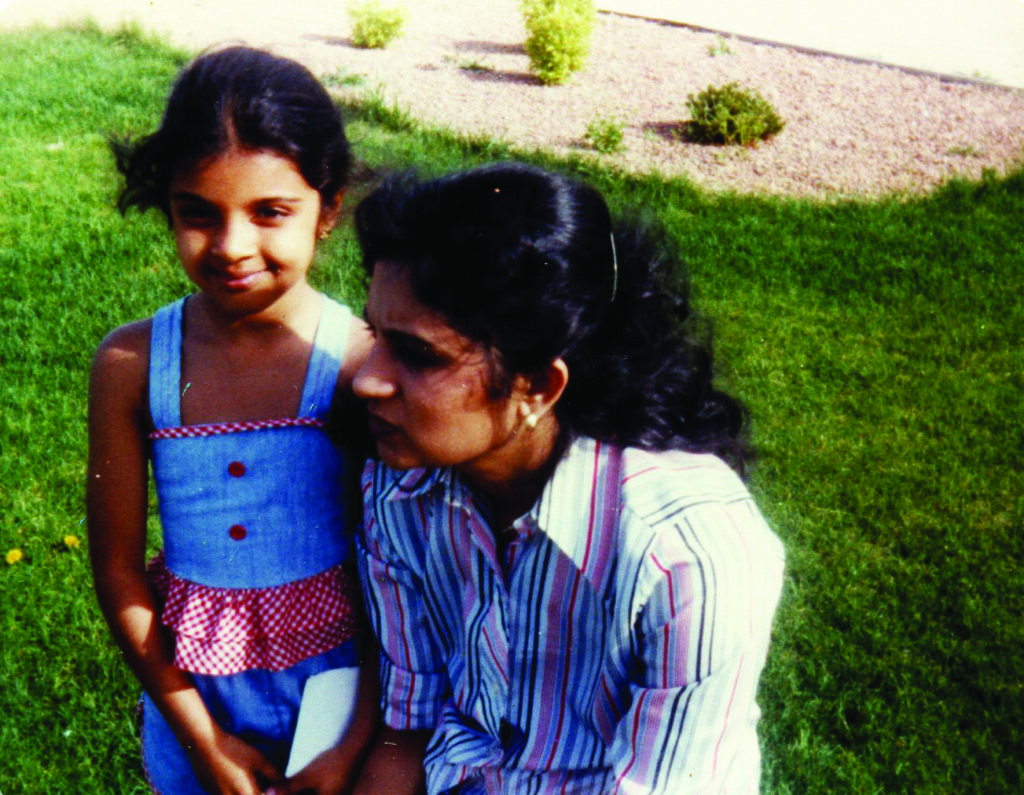From Madras to Minnesota:
Mother & Daughters, Dancing for the Gods
By Lavina Melwani
[dropcap]T[/dropcap]his is the love story of an immigrant from Madras for the dance form of her childhood, of how she carried its rhythms to an unknown, new world, passing it on not only to her two daughters – one born in India, the other in America – and also to the larger world, the hinterland of America – Minnesota.
Who would have thought that a young aspiring dancer from Chennai would have to travel all the way to America to really understand the ancient dance form of Bharatanatyam? This classic dance is indeed the Dance of the Gods –it gives humans celestial power and beauty and joy, and also the strength to face the vicissitudes of life. Like a powerful wind on a sailing ship, it can propel you from one country to another on the other side of world, and serve as an anchor and bulwark to survive and flourish in a new world.
This really is a love story of a family of devoted dancers – mother and daughters – and the dance guru who changed their lives. They in turn have brought her inimitable style of dancing to an American audience which has been thoroughly engaged by this very special style of Bharatanatyam.

Ragamala Dance Company
2016
[dropcap]T[/dropcap]he guru is the legendary Indian dancer Alarmel Valli – one of India’s greatest dancers who has been conferred the Padma Bhushan by the President of India and the award of Chevalier of the Arts and Lettres by the Government of France. The dancers who have carried her lineage to the west are a remarkable trio – mother Ranee Ramaswamy and daughters Aparna and Ashwini who make up the core of the Ragamala Dance Company which has won accolades not only in the US but around the world. They are the traveling storytellers who have traversed the continents carrying the magical and unique style of Alarmel Valli to new audiences.
[dropcap]R[/dropcap]anee and Aparna Ramaswamy’s Ragamala Dance Company, now in its 30th year, is an independent dance company based in Minneapolis, Minnesota. Over the years it has had a dance dialogue with national and international artistes and created many presentations including Fires of Varanasi: Dance of the Eternal Pilgrim at the 45th Annual Soorya Festival in October 2022 at various locations in Kerala, India. This six-performance engagement is part of Ragamala’s 22/23 Season, which culminates with a 30th Anniversary Gala Celebration in July 2023.
The intriguing thing is that Ranee, Aparna and Ashwini never encountered Alarmel Valli in India – they had to travel all the way to Minnesota, Minneapolis to make this life-changing connection.
The story started decades ago with Ranee, the daughter of an entomologist father and a homemaker mother, who grew up in a very traditional joint family of religious Iyer Hindu Brahmins in Chennai when it was still called Madras. Ranee remembers learning slokas at a very early age, constantly visiting temples and also having her hair shaved in a Hindu ritual when she was a young girl.
[dropcap]C[/dropcap]hennai may be the home of Bharatanatyam but in her deeply religious family it was not given much importance and she had never even seen a performance on stage. However, a class once taken at the age of 5 with a cousin opened her eyes to the magic of dance. Remembers Ranee, “I was so enthralled by the idea of imparting this gorgeous lesson through steps and movements with performances on stage that I begged my parents to get me classes. So when I was seven or eight, they found a teacher who had just started classes at a ladies club, and when those ended, the teacher came to teach me at home.” Ranee learned dancing till the age of 15 but she never had an arangetram, as her uncles and cousins did not approve of girls performing on stage – they felt the money was better saved for her wedding and dowry!
And so, real life took over.
Ranee recalls, “I had an arranged marriage at 20, by 23 I had my daughter Aparna and by 26 I had left India. So my dance career ended like that – but then I came to Minneapolis and it flowered into something awesome and wonderful.”
When she first came to Minneapolis, the Indian population which is now 50,000, consisted of just 100 people and they embraced Ranee and her family as new immigrants. Social life revolved around the community and the Hindu temple, and since she knew how to dance, she was invited to perform at Diwali festivities. She recalls, “People around me really enjoyed it, and asked me if I would teach the kids but I didn’t know enough to teach them. So again, I ended up in India, a year and a half after coming here, trying to find teachers who would teach me so that I could learn all the basics and come back.” She did come back and became the dance teacher in her new adopted home.
[dropcap]W[/dropcap]hen Alarmel Valli came to Minneapolis for a performance, Ranee was mesmerized by her style of performing and took a two-week extensive residency with her..This was the teacher she had never had, the dance training she never got so Ranee wholeheartedly adopted her as her guru. and every year she and Aparna would travel to Chennai to study with her and that learning process has continued over the years.
“When I started learning from Valli, I saw Bharatanatyam as something amazing. It wasn’t just the basic Bharatanatyam – it was so exquisite that I wanted the world to see it, not just the Indian community,” says Ranee. She did this by collaborating with American artistes and so making it more accessible to local audiences. The very first production was held at Great American History Theater with sitarist-composer David Whetstone in 1994, incorporating the dancers’ movements to drumming and lines of poetry by Whetstone.
It was a labor of love and the mother-daughter who were co-artistic directors kept choreographing, often with Alarmel Valli, to engage the American audiences. The progression of Ragamala became an American success story in the ensuing years by putting together funding for collaborative works with various partners including Walker Art Center, Theater Mu, the Miami University Performing Arts Series, Arts Midwest, National Endowment for the Arts, McKnight Foundation. In 2011 the company performed at the Maximum India Festival at the Kennedy Center in Washington DC.
When younger daughter Ashwini joined the company after finishing college, she being born and brought up in America, brought her own perspectives to the company as choreographer associate, creating some new works which took the dance story to a wider audience.
[dropcap]O[/dropcap]ver the years more dancers joined the company and many ancient stories were presented with a contemporary spin, making old stories new and relevant again. Sacred Earth, which was presented in India while on tour, explored the relationship between nature and humans, and incorporated the philosophy and art of Kolam chalk drawings on stage. Fires of Varanasi explores the sacred rituals around the city of Varanasi. Written in Water was created from Paramapadam, the original game that ‘Snakes and Ladders‘ is based on. Interwoven with that is a 12th century Sufi poem about enlightenment called The Conference of the Birds, which describes seven transitional states of being.
Indeed, these ancient stories carry truths which are very relevant in today’s troubled times, be it the crisis in Ukraine or the hard reality of climate change, Says Aparna, “So we take it very much to heart and we try to bring the old to today’s stage.”
She herself started very young: “I was drawn to it, and had a love for the dance and the music and I think for me, because I was a new immigrant, it was a way for me to connect, in perhaps ways I didn’t understand with my cultural roots and as I got slightly older, I was just always fascinated with watching dance and listening to classical Carnatic music.”
For her the meeting with Alarmel Valli was life-changing “ When we met our teacher, I was eight or nine years old; in that instant I was just floored, absolutely captivated by watching her perform. And she still continues to captivate me even more deeply after all these years. So I think for me, it was love at first sight. From then on, we spent four months every year in India with her. So it was a very focused time, and we were so fortunate to have time studying one-on-one with her mother.”

[dropcap]F[/dropcap]or Ashwini, who was born and raised in America, dance was never the laser focus of life as it was for her mother and older sister. She says, “For the first many years it was more of a hobby for me. I took dance always as an activity to appease the family and keep in the loop basically with the culture.” She was very interested in trying to find what her friends were trying – gymnastics, ice skating, piano and flute, visual art and reading. All these different experiences were a part of her life.
She had joined the company at the age of 12, participating in all the productions. Now after college she came home to the dance world once again. “So I came home to try it out in reverse. I said if I didn’t try it now it wasn’t going to happen. So I spent many years learning, then relearning; kind of re-shifting how I approach this art form that is so vast that you are forever a student.”
Ashwini has since then spent a lot of time working on both the craft of dance and choreography and is deeply involved in both fields. She had to figure out her own contribution, establishing an aesthetic within the Ragamala umbrella: “It’s just through my perspective as someone who was born here and has had more influences from this country, and then kind of going back to exploring my Indian heritage through dance and through the themes I select.”
Indeed, Ranee, Aparna and Ashwini have each had their own varied interactions with their two homelands and that further enriches their performances and world view. Bharatanatyam is the dance vehicle which is immersed in spirituality, mythological stories and metaphysical concepts. Says Aparna, “I think this incredibly rich and complicated spiritual world is in some ways so open and just so incredibly accepting. It is all accessed through the dance and the music in a way that’s very, very personal, and in a way that’s very visceral.”
For mother and daughters dance is so much more than just an incredible art form – it is as vital as a heartbeat, necessary as a breath. In the essence of living, it is, simply put, a form of prayer






